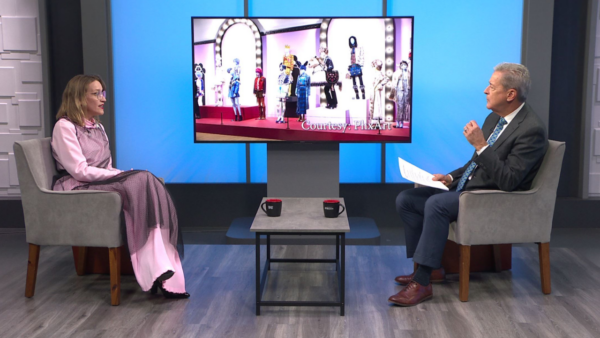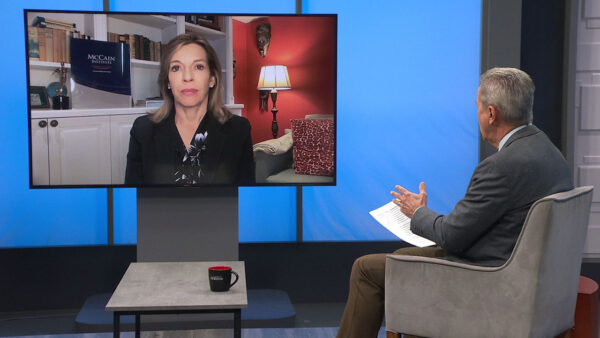Meteorologists are suggesting possibility of a developing “El Nino” weather pattern, which means that Arizona could be in store for a wetter than normal winter. Arizona State Climatologist Nancy Selover will tell us more.
Ted Simons: Meteorologists are suggesting the possibility of a developing El Nino weather pattern, which means Arizona could be in store for a wetter than normal winter. Joining us now is the state climatologist for Arizona, Nancy Selover.
Nancy Selover: God to see you.
Ted Simons: And I'm just -- I'm happy to hear that El Nino is a possibility. First of all, tell us what is El Nino?
Nancy Selover: El Nino is a circulation pattern where we get warmer than normal waters in the Equatorial Pacific, and that allows us potentially to get a stream of subtropical moisture that comes underneath that high pressure and catches the lower tier of the U.S.
Ted Simons: So instead of going above us, and we just get a dry winter like we've had, we get tropical moisture during the winter.
Nancy Selover: Yes.
Ted Simons: And this is because of what, weaker trade winds?
Nancy Selover: The trade winds move from east to west, and so they weaken and we end up getting more of the warm water from the eastern Pacific to move to the central Pacific.
Ted Simons: So --
Nancy Selover: Western Pacific to the central Pacific.
Ted Simons: What are meteorologists seeing right now?
Nancy Selover: We've been in a La Nina situation where we have colder weather there in the Equatorial Pacific and we're starting to see the development of little bit warmer water, we thought this was going to happen this past winter as well. But about October it just sort of fizzled out and went away.
Ted Simons: I was going to ask that, is it possible we could see an El Nino forming now and then by the time El Nino is supposed to appear, later in the year, it's all kaput?
Nancy Selover: Yes, that's possible. We've had that happen.
Ted Simons: Is it likely?
Nancy Selover: I don't know. Right now the confidence that we have that El Nino is going to form is not real high. The climate prediction center is putting out all their outlooks through the next months, as being equal chances of a wet or dry year for us.
Ted Simons: The idea of an El Nino forming in the southern hemisphere in the next few months, how does that play into what happens to us, again, later in the year? What is that dynamic all about?
Nancy Selover: It's just the ability to tap into that subtropical moisture and if we get that, we still have to have storm systems form, just because we have moisture doesn't mean we'll get any rain. So we really need -- It's the possibility of being able to tap into that additional moisture.
Ted Simons: And the rain here in the United States would mean Arizona, California, how far north?
Nancy Selover: Kind of the -- It's the lower tier of states. It might catch southern Colorado, southern Utah, but definitely Arizona, New Mexico, Texas, and the southeast as well.
Ted Simons: Because these are tropical -- This is tropical air, does that mean higher snow level, and is that necessarily a good thing for Arizona?
Nancy Selover: If we can get the precipitation at the moment I am not too concerned about whether -- Exactly where that snow line is, because if we get a cold enough weather system, we will end up with snow as opposed to rain.
Ted Simons: El Nino, obviously right now, we would take it in a heartbeat. However, if it's a strong El Nino, you could be looking at some flooding, you could see mudslides, a lot of damage too.
Nancy Selover: Sure. Southern California and much of California has that as a big problem for them. We don't quite have as much flooding here from the winter precipitation.
Ted Simons: As far as Atlantic hurricanes, do I understand fewer of those with an El Nino? Or do we know that?
Nancy Selover: I don't really know that. I'm not an expert on that, so I'm not going to put my neck out there.
Ted Simons: Again, still no guarantee of an El Nino, but it's worth watching.
Nancy Selover: Oh, yes. It's definitely worth watching, and cross your fingers.
Ted Simons: When will we be more sure?
Nancy Selover: September-October when we see, have we really swung that direction. But even earlier in the summer we'll see if we're starting to swing towards those much higher than normal temperatures in the sea surface in the Equatorial Pacific.
Ted Simons: Do those temperatures have anything to do at all with our monsoon?
Nancy Selover: No.
Ted Simons: Not a bit?
Nancy Selover: No.
Ted Simons: Every year I get you guys on and I try to figure out how can we predict the monsoon? And you always say, there's no way to do it.
Nancy Selover: We have yet to find a way to do it there. Are very short-termTELE connections is that happen, but they're on the order of days out. If we see one of those we can have a good idea we might be getting wetter in that short period, but this far we don't have a good clue.
Ted Simons: El Nino, La Nina and the neutral in the middle, absolutely nothing, either before or after a monsoon season.
Nancy Selover: Right.
Ted Simons: That's no fun.
Nancy Selover: I know.
Ted Simons: That's foot going to help us.
Nancy Selover: I know.
Ted Simons: You can tell us about the next few months in the spring, and it sounds like we're going to be hot and dry?
Nancy Selover: We're looking like we could be hot and dry. There were a couple models, different models that predict things, and two of them thought we might have a wet may. I'm not going to hang my hat on two of the . Because we couldn't really see why they were saying that.
Ted Simons: So it's going to be warmer and it's going to be -- Dryer than usual, or just dry period?
Nancy Selover: Just dry period. We don't have a signal of wetter or dryer or normal monsoon. We turned out to be a wet monsoon last year, that was good, because we've had this will be our third dry winter in a row.
Ted Simons: Not only that, but did I read this was the second warmest winter on record for Arizona?
Nancy Selover: I believe it is, yes.
Ted Simons: So what is going on? In the grand scheme of things, in the ,-foot view of our weather pattern, what's going on?
Nancy Selover: Well, this winter we had that huge high pressure that set up off the coast of the -- Off the West Coast, and that caused all the storm systems to go over the top, and then they'd come down on the other side of the Rockies, and then they'd sweep through and they would suck in that cold Arctic air. So they were really cold and snowy, yet here we are under high pressure, nice clear skies. Sunny conditions.
Ted Simons: Is that a La Nina or a neutral pattern?
Nancy Selover: This was neutral.
Ted Simons: Because La Nina usually ends up with stuff like that.
Nancy Selover: Yeah. We've had wet La Ninas, we've had dry El Ninos, and wet neutrals.
Ted Simons: So a state climatologist, are you -- Do you feel more confident every year? Is the science and the research and the data, is it improving every year on this kind of thing?
Nancy Selover: We're discovering more and more little nuances with the teleconnections, so we'll be able to do a little better at our forecasting, but when there's no signal there, there's really no way to read anything into it.
Ted Simons: And as far as the drought is concerned, it continues regardless of El Nino, La Nina, or all points in between.
Nancy Selover: Yes. Because we've had -- We're somewhere in the neighborhood of the th year of drought, and that doesn't mean all years have been dryer than normal. We had really wet years. But they're sporadic. A nice winter would be good, but we need several in a row to bring us back.
Ted Simons: Is there any indication that it's going to end soon? Historically, how long have these droughts gone in Arizona?
Nancy Selover: In the mid s to the mid s was about years.
Ted Simons: Oh, my goodness.
Nancy Selover: In recorded history we have had them longer than this. Way before that in the s there was a -year drought. So we're hoping that's not where we are.
Ted Simons: Indeed. As far as wetter than normal, do those last as long, or is drought usually lasting longer?
Nancy Selover: They're kind of similar. The mid 70's to the mid 90's, about year fairly wet before and before the 40's we had about , really wet period as well.
Ted Simons: We'll keep an eye on El Niño and hope for the best. It's good to have you here.
Nancy Selover: Thanks.
Nancy Selover:State Climatologist, Arizona;























